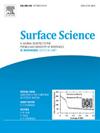铑插层SiC/石墨烯界面用于CO2电化学还原:理论研究
IF 2.1
4区 化学
Q3 CHEMISTRY, PHYSICAL
引用次数: 0
摘要
电化学将二氧化碳还原为有价值的燃料和化学品是一种很有前途的二氧化碳再利用方法。本文利用自旋极化DFT计算研究了CO2在铑插层SiC/石墨烯表面的还原机理。然后探讨了电化学CO2还原为CO、HCOOH、CH3OH和CH4等产物的能量优选途径。结果表明,对于该催化剂材料,CH4的生成比其他产物更有利。与中间CO吸附物相比,中间HCOOH吸附物的反应途径更有利。在整个还原反应中,中间羧基吸附物的形成被认为是限制自由能速率的步骤。计算出SiC/Rh/石墨烯催化剂的极限电位为0.36 V,并且该催化剂在析氢反应中也表现出竞争性选择性。本文章由计算机程序翻译,如有差异,请以英文原文为准。

The use of an Rh-intercalated SiC/graphene interface for CO2 electrochemical reduction: A theoretical investigation
Electrochemical reduction of CO2 to valuable fuels and chemicals is a promising way to reuse CO2. The mechanism of CO2 reduction on the Rh-intercalated SiC/graphene surface has here been investigated using spin-polarized DFT calculations. The energetically preferred pathways for the electrochemical CO2 reduction to products like CO, HCOOH, CH3OH, and CH4 were then explored. The results showed that the production of CH4 was more preferred compared to the other products for this specific catalyst material. The reaction pathway via an intermediate HCOOH adsorbate was found to be more favored, as compared with an intermediate CO adsorbate. Also, the formation of an intermediate COOH adsorbate was identified as the free energy rate-limiting step in the complete reduction reaction. The calculated limiting potential for the SiC/Rh/graphene catalyst was 0.36 V, and this catalyst was also found to exhibit a competitive selectivity with respect to the hydrogen evolution reaction.
求助全文
通过发布文献求助,成功后即可免费获取论文全文。
去求助
来源期刊

Surface Science
化学-物理:凝聚态物理
CiteScore
3.30
自引率
5.30%
发文量
137
审稿时长
25 days
期刊介绍:
Surface Science is devoted to elucidating the fundamental aspects of chemistry and physics occurring at a wide range of surfaces and interfaces and to disseminating this knowledge fast. The journal welcomes a broad spectrum of topics, including but not limited to:
• model systems (e.g. in Ultra High Vacuum) under well-controlled reactive conditions
• nanoscale science and engineering, including manipulation of matter at the atomic/molecular scale and assembly phenomena
• reactivity of surfaces as related to various applied areas including heterogeneous catalysis, chemistry at electrified interfaces, and semiconductors functionalization
• phenomena at interfaces relevant to energy storage and conversion, and fuels production and utilization
• surface reactivity for environmental protection and pollution remediation
• interactions at surfaces of soft matter, including polymers and biomaterials.
Both experimental and theoretical work, including modeling, is within the scope of the journal. Work published in Surface Science reaches a wide readership, from chemistry and physics to biology and materials science and engineering, providing an excellent forum for cross-fertilization of ideas and broad dissemination of scientific discoveries.
 求助内容:
求助内容: 应助结果提醒方式:
应助结果提醒方式:


